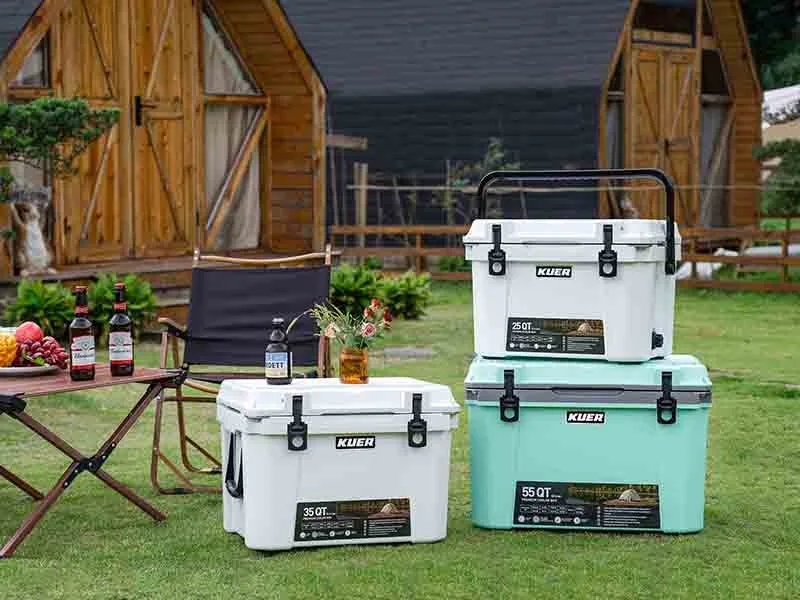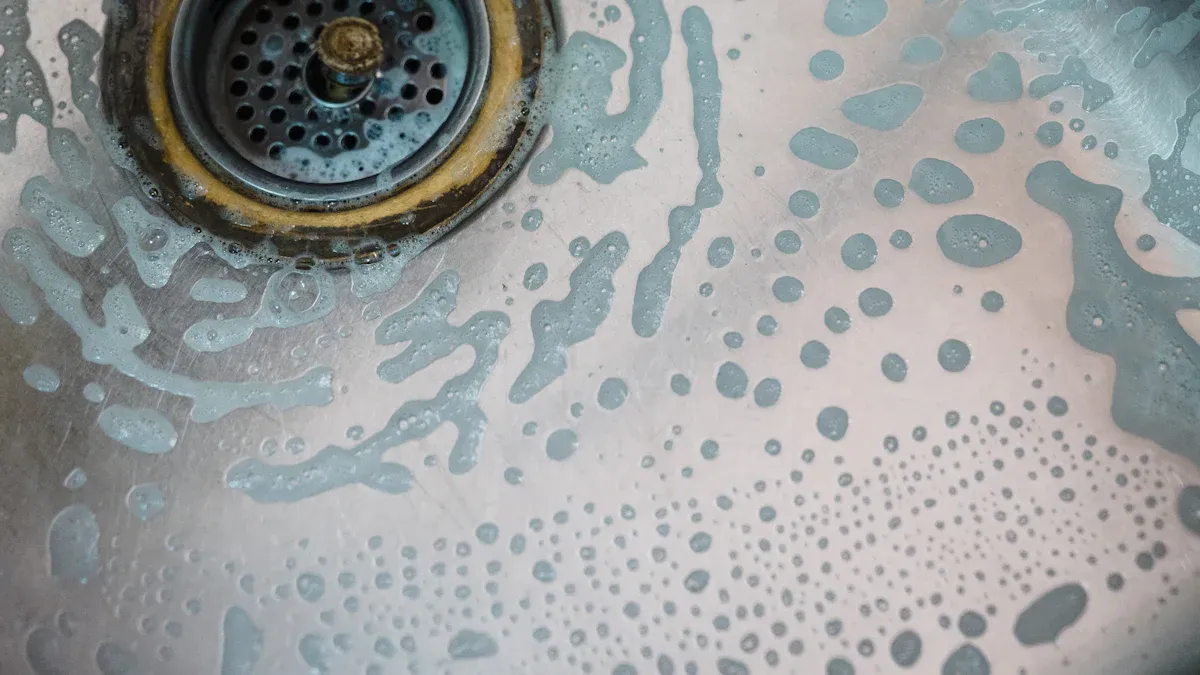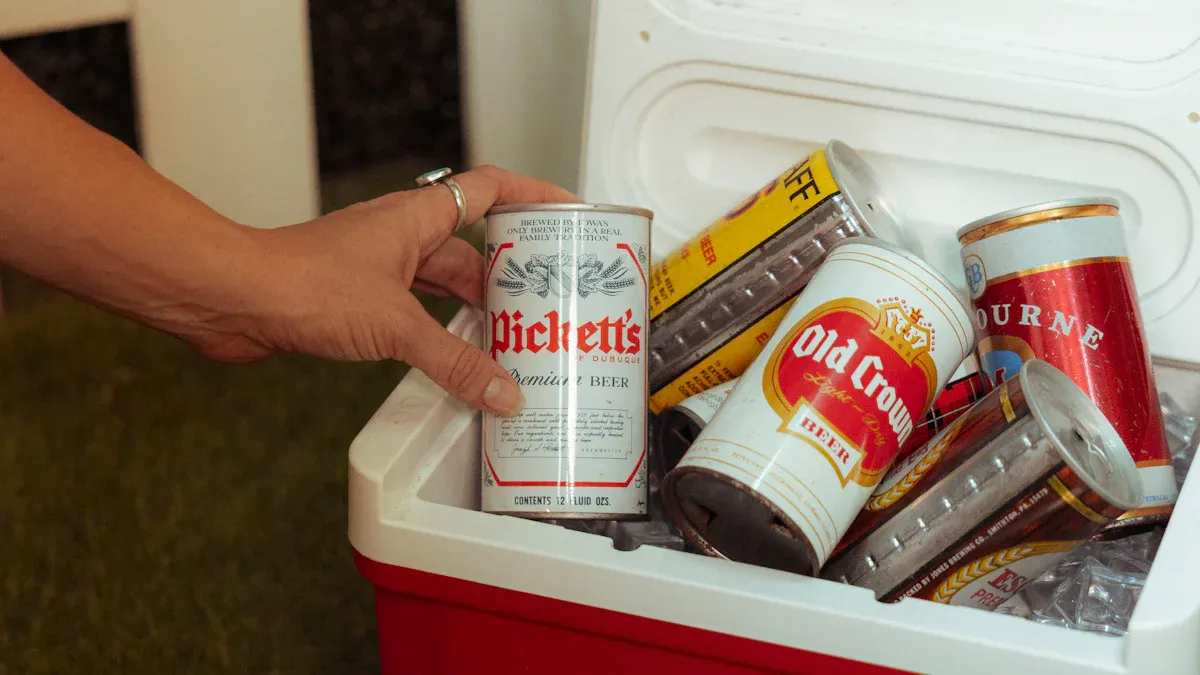

Choosing between a hard lunch cooler and a soft lunch cooler depends on your needs. Many working professionals and students enjoy soft coolers because they are light and easy to carry. Recent improvements mean you get better insulation and durable exteriors, but these coolers usually do not keep things cold as long as a hard lunch cooler. If you need something tough for outdoor adventures or longer trips, a hard lunch cooler gives you strong protection and longer ice retention. Think about what matters most to you—portability, durability, ice retention, cost, storage, and how you plan to use different types of coolers.
- Soft coolers work well for daily lunches and city life.
- Hard lunch coolers fit outdoor use and rough conditions.
Quick Comparison
Features Table
You want to know what sets hard-sided cooler and soft-sided coolers apart. The table below highlights the key features you should consider when choosing between these two types of coolers:
| Feature | Hard Lunch Coolers | Soft Lunch Coolers |
|---|---|---|
| Durability | Made from tough, high-density materials; very rugged and long-lasting | Fabric exterior with water and stain repellent coating; less durable, prone to wear and tear over time |
| Ice Retention | Superior ice retention with thick insulation and advanced sealing; keeps ice for days | Good insulation but generally less effective; some premium models can rival hard coolers |
| Capacity | Larger capacity suitable for family or group use | Generally smaller sizes; variety from small lunch boxes to larger picnic coolers |
| Portability | Heavier and bulkier; less convenient for solo or long-distance carrying | Lightweight, flexible, easy to carry with adjustable straps or handles; folds for storage |
| Convenience | Multi-functional features like built-in bottle openers, cup holders, can double as seating or table | Wide variety of styles (wheeled, backpack, tote); easy access designs like zipperless coolers |
| Storage | Rigid structure makes storage cumbersome | Can be folded or rolled up when empty for easy storage |
| Price | Generally more expensive due to materials and performance | Usually more affordable, but varies by style and features |
| Lifespan | Long-lasting due to robust construction | Shorter lifespan due to fabric wear but designed for everyday use |
Tip: If you need a cooler for long camping trips or rugged outdoor use, a hard-sided cooler offers the best durability and ice retention. For daily lunches or quick outings, soft-sided coolers provide lightweight convenience and easy storage.
Pros and Cons
When you compare hard-sided coolers and soft-sided coolers, you notice each has unique strengths. Here is a clear breakdown:
Hard Lunch Coolers
-
Pros:
- Strong, impact-resistant construction
- Thick insulation for excellent cold retention (up to 36 hours in some models)
- Leak-proof design and secure latches
- Useful for outdoor adventures and job sites
- Some models, like yeti coolers, can double as seats or tables
-
Cons:
- Heavier and bulkier, less convenient for carrying long distances
Soft Lunch Coolers
-
Pros:
- Lightweight and flexible for easy carrying
- Multiple pockets and storage options
- Some soft-sided coolers include removable hard liners for extra protection
- Many styles, including backpack and tote designs
- yeti coolers in this category offer premium insulation and waterproof features
-
Cons:
- Usually require ice packs to keep food cold
- Less insulation than hard-sided coolers
You can see that both types of coolers serve different needs. Hard-sided cooler models like yeti coolers excel in durability and ice retention, while soft-sided coolers shine in portability and convenience. When you look at the key features, you can match your choice to your daily routine or adventure plans.
Portability
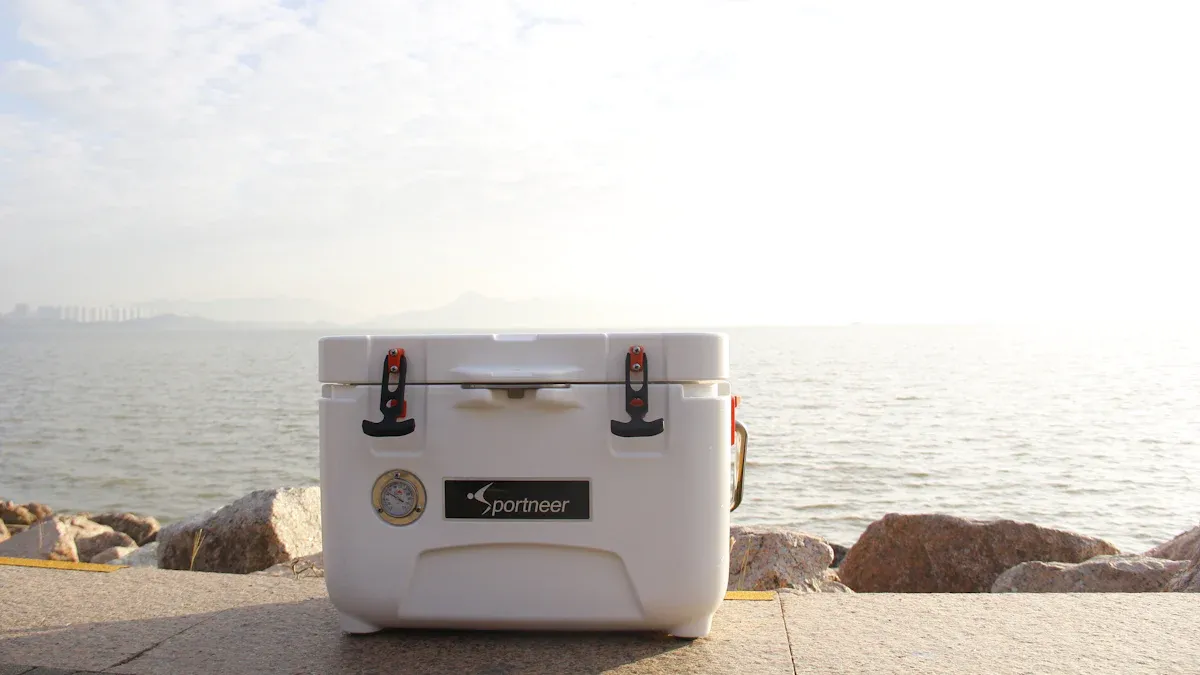
Weight and Size
When you choose between hard and soft lunch coolers, weight and size play a big role in how easy they are to carry. Hard lunch coolers use tough materials like rotomolded plastic, which makes them heavier and bulkier. For example, the Pelican 8QT Personal Cooler & Dry Box measures 13.40 x 9.45 x 10.50 inches and weighs about 5 pounds. Soft lunch coolers, such as the Igloo 16-Can Softsided Insulated Lunch Box or the YETI Daytrip Packable Lunch Bag, have smaller dimensions and use lightweight fabrics. Most soft coolers weigh much less, though exact numbers are not always listed. You can see the difference in the table below:
| Cooler Type | Product Example | Exterior Dimensions (inches) | Weight (pounds) |
|---|---|---|---|
| Hard-sided | Pelican 8QT Personal Cooler & Dry Box | 13.40 x 9.45 x 10.50 | 5 |
| Soft-sided | Igloo 16-Can Softsided Insulated Lunch Box | 10.43 x 8.46 x 10.04 | N/A (generally lighter) |
| Soft-sided | YETI Daytrip Packable Lunch Bag | 8.7 x 6.39 x 11.0 | N/A (generally lighter) |
| Soft-sided | Coleman Chiller Series Insulated Soft Cooler 9 Can | 10.25 x 7.25 x 8.5 | N/A (generally lighter) |
Note: Hard lunch coolers are bulkier and heavier, while soft lunch coolers are compact and easy to handle.
Carrying Ease
You want a cooler that fits your lifestyle. Outdoor gear experts say soft coolers are much easier to carry because they use lightweight materials and offer flexible strap designs. You can find soft coolers with backpack straps, cross-body options, or adjustable handles. These features help you carry your lunch over long distances, through parks, or on hikes. Hard lunch coolers have sturdy handles but feel heavier and less comfortable for walking far. They work best when you keep them in a car or at a campsite.
Here is a quick comparison of carrying features:
| Factor | Soft Lunch Coolers | Hard Lunch Coolers |
|---|---|---|
| Weight | Generally lighter due to nylon or vinyl materials | Heavier due to rotomolded plastic and heavy-duty materials |
| Design Features | Ergonomic straps (backpack, cross-body, adjustable handles) | Bulkier, heavier handles; less convenient for long distances |
| Ease of Carrying | Easy to carry over varied outdoor settings | Best for stationary use or vehicle transport |
| Portability Use Case | Ideal for long walks, hikes, and day trips | Preferred for car trips or stationary use |
If you need to carry your cooler every day or over rough terrain, soft lunch coolers give you the best portability. Hard lunch coolers offer more protection but are better for trips where you do not need to walk far.
Durability
Hard Lunch Cooler Strength
You want a lunch cooler that stands up to tough conditions. Hard lunch coolers use strong materials like rotomolded plastic, heavy-duty polyester, and reinforced plastics. These materials give the cooler a solid shell that resists drops, bumps, and rough handling. Rotomolded plastic forms a thick, impact-resistant body. Heavy-duty polyester and treated nylon add extra strength and help prevent cracks or leaks. You can see how different materials affect durability in the table below:
| Lunch Cooler Model | Material Type | Durability Rating (1-10) |
|---|---|---|
| Yeti Daytrip Packable Lunch Bag | Treated Nylon | 9 |
| Carhartt Insulated 2 Compartment Cooler | Polyester | 8 |
| Igloo Modern Lunch | Hard Plastic | 7 |
| Corkcicle Crush Proof Cooler | Reinforced Plastic | 8 |
Hard lunch coolers often include features like reinforced seams, heavy-duty latches, and thick polyurethane foam insulation. These features help the cooler keep its shape and protect your food. You get leak-resistant seals and sturdy locks that keep the lid closed, even if you drop the cooler. KUER uses advanced rotomolded construction and seamless designs to make their coolers tough and reliable. Their coolers pass drop tests from heights up to 15 meters, showing strong resistance to cracks and leaks.
Tip: If you need a cooler for construction sites, camping, or outdoor work, choose a hard lunch cooler with rotomolded plastic and reinforced parts. These coolers last for years and keep your food safe.
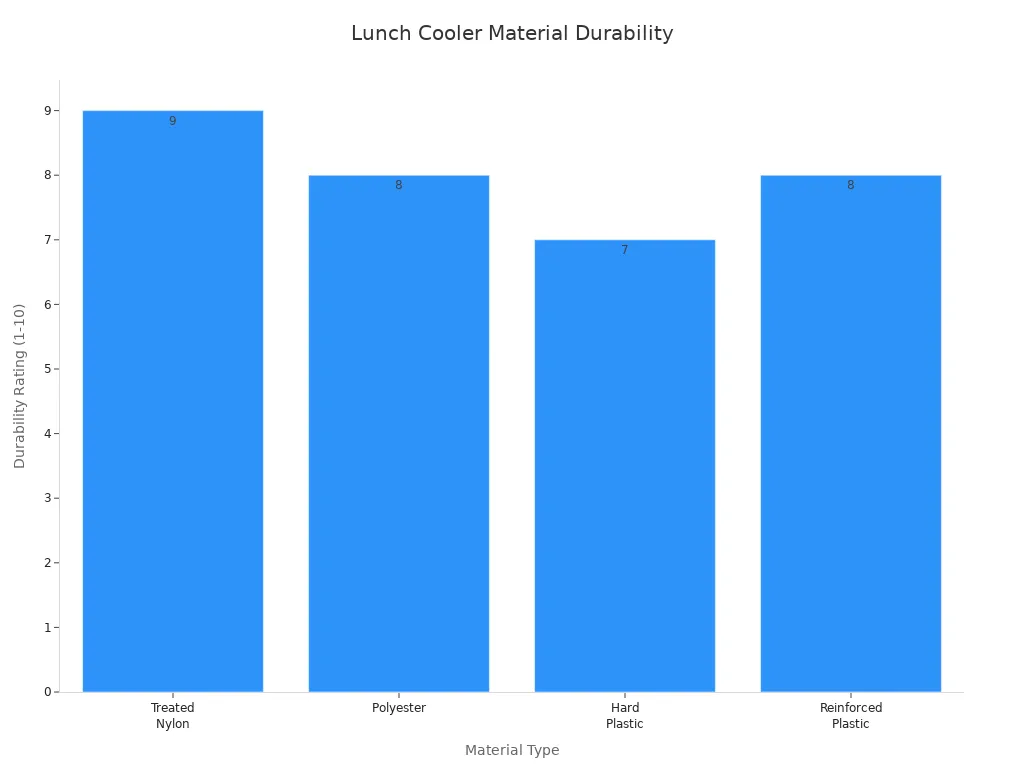
You can trust KUER’s quality control. Their team checks every cooler for material strength, insulation, and leakproof performance. KUER holds ISO 9001:2015 and BSCI certifications, which means their coolers meet top industry standards. Their coolers use LLDPE for UV resistance, PU foam for thermal retention, and food-grade PP for safe storage. KUER offers a 5-year warranty, showing confidence in their product durability.
Soft Cooler Materials
Soft-sided coolers use flexible materials like treated nylon, heavy-duty polyester, and waterproof fabrics. These materials make soft cooler bags light and easy to carry. Treated nylon and polyester resist punctures and stains, but they do not protect as well against drops or rough use. Soft-sided coolers often have reinforced stitching and leak-resistant zippers. You get extra pockets and adjustable straps for convenience.
Soft-sided coolers work best for daily lunches, picnics, and short trips. They fold up for easy storage and fit in backpacks or tote bags. Some premium soft cooler bags, like yeti coolers, use thick insulation and waterproof coatings to keep food cold and dry. These coolers offer good thermal performance for a few hours. You can rely on soft-sided coolers for city life and quick outings.
- Soft-sided coolers are lighter and easier to carry than hard lunch coolers.
- Treated nylon and polyester provide good resistance to wear and tear.
- Reinforced stitching and leak-resistant zippers add extra protection.
- Soft cooler bags fold up for storage and fit in small spaces.
KUER’s soft-sided coolers use high-quality fabrics and advanced insulation. Their R&D team holds over 50 patents for cooler design and durability. KUER inspects every cooler for strength and performance, from raw materials to final packaging. Their soft-sided coolers pass drop tests and meet strict quality standards.
Note: Soft-sided coolers give you flexibility and convenience. If you need a cooler for school, work, or travel, choose a soft cooler bag with waterproof and thermal features.
| Feature | Impact on Durability and Drop Performance |
|---|---|
| Rotomolded shell | Prevents cracks and leaks, providing extreme durability |
| Multi-layer insulation | Adds structural strength and helps maintain shape under pressure |
| Heavy-duty latches | Keeps lid securely closed, preventing spills during impacts |
| Reinforced seams | Enhances toughness for daily rough use and drop resistance |
- Hard lunch coolers have durable construction that withstands drops and rough outdoor use.
- Rotomolded polyethylene shells prevent cracks and leaks.
- Heavy-duty latches and reinforced seams add to leak prevention and toughness.
- Soft-sided coolers vary in durability depending on fabric thickness.
- Soft-sided coolers are lighter and more portable but less resistant to impacts.
You can see that hard lunch coolers offer the best protection for outdoor adventures and tough jobs. Soft-sided coolers give you lightweight convenience for everyday use. KUER’s expertise in manufacturing and quality control ensures you get a cooler that matches your needs, whether you choose a hard lunch cooler or a soft cooler bag.
Ice Retention
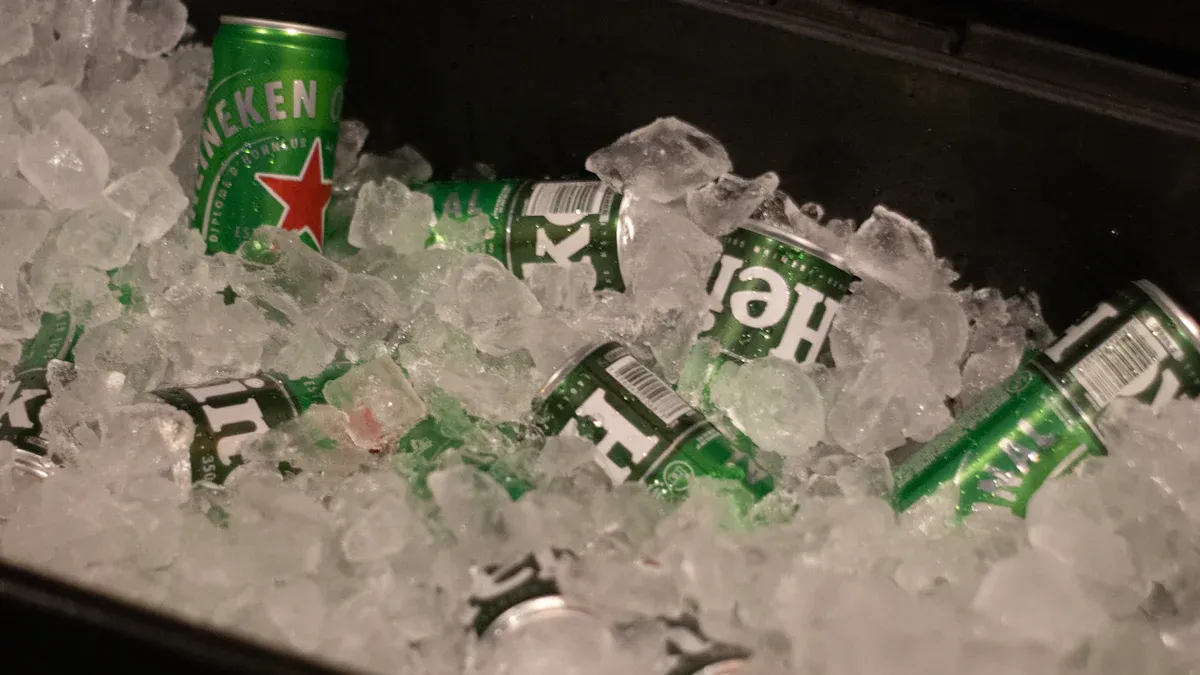
Short Trips
When you pack your lunch for a short trip, you want your food and drinks to stay cold and fresh. Soft coolers work well for these situations. You can carry them easily, and they keep your items cool for several hours. Most soft coolers use advanced insulation technologies, such as multiple layers of insulation and thermal linings, to help maintain temperature. Some premium soft coolers, like yeti coolers, can even match the performance of smaller hard coolers for a few hours.
- Hard coolers retain ice for days because of thick insulation and tight seals.
- Soft coolers keep ice for a reasonable period, perfect for short trips or picnics.
- Hard coolers offer rugged durability and exceptional ice retention.
- Soft coolers provide portability and convenience for daily use.
If you need to keep your lunch cold for a school day or a quick outing, soft coolers give you the flexibility and light weight you want. For longer cold times, hard coolers give you extra peace of mind.
Long Outings
For long outings, such as camping or all-day events, you need coolers with exceptional ice retention capabilities. Laboratory tests show that hard lunch coolers outperform soft coolers in these situations. Hard coolers, including yeti coolers, use rotomolded designs and gasket lids to lock in cold air. These coolers can keep ice for 8 hours or more, even in hot weather. Some models, like the Pelican 14QT, hold ice for up to 36 hours.
| Cooler Model | Type | Ice Retention Performance | Key Features and Insulation Type |
|---|---|---|---|
| KUER Hard Shell Lunch Box | Hard shell | Keeps ice for 8+ hours at 84°F heat | Rotomolded design, multi-layer insulation, gasket lid |
| Pelican 14QT | Hard shell | Ice retention up to 36 hours with ice packs | Rugged rotomolded shell, secure latches |
| Grizzly Kenai To-Go | Hard shell | Long-lasting ice retention (hours) | Heavy-duty build, reinforced corners, high-density foam insulation |
| Arctic Zone Titan Zipperless | Soft cooler | Keeps food under 40°F for up to 6 hours; under 50°F for up to 12 hours | SuperFoam insulation, triple-layer ColdBlock base, zipperless lid |
| Carhartt Insulated Classic | Soft cooler | Ice retention about 8 hours | Water-repellent polyester, tough lining |
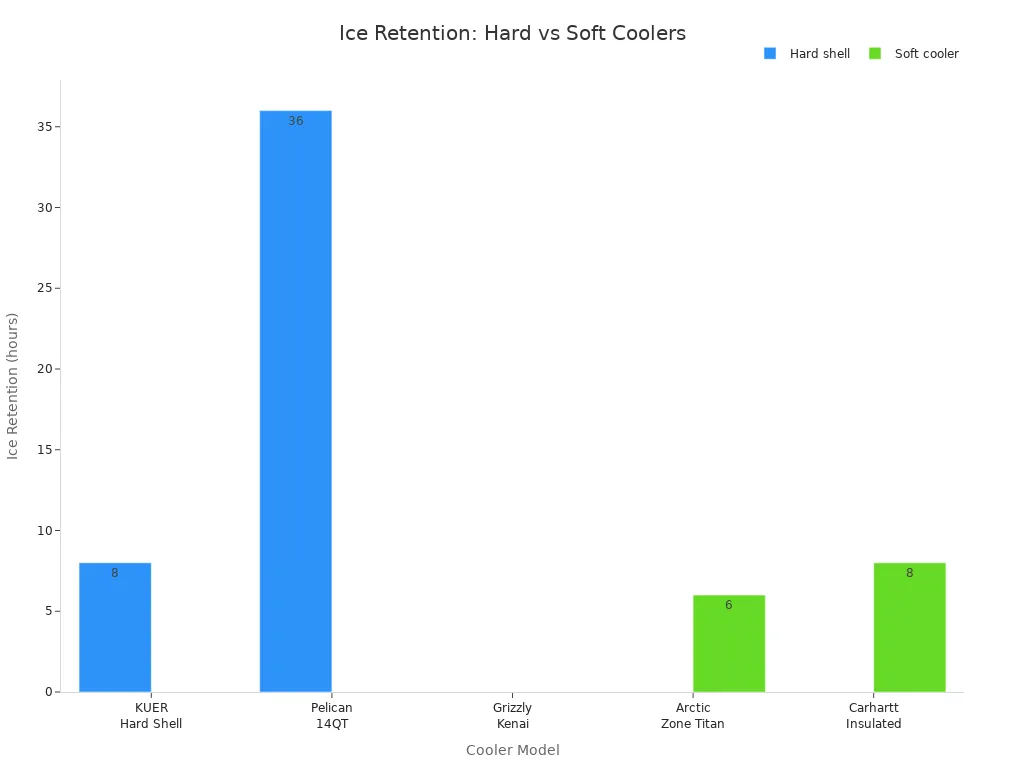
You can see that hard coolers deliver much longer ice retention than soft coolers. If you plan a long day outside, choose a hard cooler for the best results. Soft coolers still work well for shorter periods and are easier to carry, but hard coolers give you the most reliable cold storage.
Cost
Price Range
When you shop for a lunch cooler, price often becomes a key factor. You will notice that hard lunch coolers usually cost more than soft lunch coolers. This happens because hard coolers use thicker materials and advanced insulation. Soft coolers use lighter fabrics and simpler designs, so they cost less.
Here is a table that shows the average price range for both types:
| Cooler Type | Average Price Range | Typical Lifespan | Approximate Cost per Year |
|---|---|---|---|
| Soft Cooler | $20 – $150 | 3 – 5 years | $7 – $30/year |
| Hard Cooler | $40 – $300 | 5 – 10+ years | $8 – $30/year |
You can see that soft coolers start at a lower price. Some premium soft coolers reach up to $150, but most fall in the $20 to $80 range. Hard coolers start around $40 and can go up to $300 for larger or more advanced models. The higher price for hard coolers reflects their tough build and longer lifespan.
Tip: If you want a cooler for daily use or short trips, a soft cooler can save you money upfront. For long-term use or outdoor adventures, a hard cooler may be worth the extra cost.
Value
You want to get the best value for your money. Hard lunch coolers last longer because they use strong materials and solid construction. Many hard coolers work well for five to ten years or more. This means you pay more at first, but you do not need to replace your cooler as often.
Soft coolers cost less, but you may need to buy a new one every few years. If you use your cooler every day, the cost per year stays low for both types. The table above shows that the yearly cost for both hard and soft coolers can be similar, depending on how long you use them.
- Hard coolers give you strong protection and long ice retention.
- Soft coolers offer lightweight convenience and easy storage.
- Both types can be a smart buy if you match the cooler to your needs.
Note: Think about how often you will use your cooler and what features matter most. A higher upfront cost can mean better value over time if you need durability and performance.
Best Uses
Work and School
You want a lunch cooler that fits your daily routine. Soft-sided coolers work best for work and school. Experts recommend these coolers because they are lightweight, flexible, and easy to carry. You can fit them into backpacks or tote bags. Many soft-sided coolers have padded handles and extra pockets for utensils or snacks. Their insulation keeps your food fresh until lunchtime. Students and professionals like the slim design and stylish look. Soft-sided coolers also handle rough use, thanks to reinforced stitching and durable fabrics. You can clean them easily after spills. For daily use, soft-sided coolers give you comfort and convenience.
Tip: Choose a soft-sided cooler with leak-proof compartments and a waterproof exterior for extra peace of mind during busy days.
Day Trips
Day trips call for a cooler that balances portability and performance. Soft-sided coolers shine here because they are light and easy to carry. You can fold them up when empty, saving space in your car or backpack. For picnics or short hikes, soft-sided coolers keep your drinks and snacks cold for hours. If you need more ice retention or plan to bring food for a group, hard lunch coolers offer better durability and longer cooling times. The table below compares the main features for day trips:
| Feature | Hard Lunch Coolers | Soft-Sided Coolers |
|---|---|---|
| Durability | Highly durable | Less durable, but flexible |
| Ice Retention | Keeps ice for days | Lasts a day or two |
| Portability | Heavier, bulkier | Lightweight, easy to carry |
| Storage | Bulky | Folds for easy storage |
| Price | Higher | More affordable |
You can pick a soft-sided cooler for a convenient all-in-one picnic solution. If you expect rough conditions, a hard cooler protects your food better.
Camping
Camping trips often last several days. You need a cooler that keeps food safe and cold. Hard lunch coolers stand out for camping. Outdoor enthusiasts trust them for their thick insulation and rugged build. These coolers keep ice for up to a week, even in hot weather. You can use them for group meals or to store perishables. Hard lunch coolers handle rough terrain and heavy use. For short hikes or car camping, soft-sided coolers offer a lighter option. They work well for snacks or drinks on the go. Your choice depends on trip length and group size.
- Hard lunch coolers: Best for multi-day camping and harsh conditions.
- Soft-sided coolers: Great for short hikes, picnics, or car camping.
Travel
Travelers need coolers that are easy to pack and carry. Soft-sided coolers fit this need because they compress and fit inside luggage or backpacks. You can use them for road trips, flights, or train rides. Look for models with leak-proof compartments and waterproof exteriors. Adjustable straps and padded handles make carrying easier. Hard lunch coolers work well if you need to protect fragile items or keep food cold for long periods. Size and capacity matter—choose a cooler that matches your meal needs. Soft-sided coolers are the ideal companion for outdoor adventures, offering flexibility and comfort for any journey.
Note: For travel, pick a cooler with strong insulation, easy-to-clean materials, and extra pockets for utensils or snacks.
Choosing the Right Cooler
Decision Guide
You want to pick the best lunch cooler for your needs. Experts suggest using a step-by-step approach to make your choice simple and effective. Follow this guide to match your lifestyle with the right cooler:
-
Check Insulation Quality
Look at the insulation material and R-value. Closed-cell foam with a high R-value (like R-5 per inch) keeps your food cold longer. If you need ice to last all day, focus on insulation first. -
Balance Size and Weight
Think about how much food or drink you need to carry. Choose a small cooler for snacks, a medium one for daily lunches, or a large one for family outings. Make sure the weight matches your carrying ability. -
Consider Portability Features
Look for padded straps, comfortable handles, or backpack designs. If you walk or travel often, portability matters most. -
Assess Durability
Check the fabric strength (denier rating), waterproof liners, sealed seams, and reinforced stitching. If you use your cooler outdoors or in tough conditions, pick one with strong materials. -
Choose the Right Closure System
Decide if you want a zipper, roll-top, or latch. Zippers and latches help prevent leaks. Roll-tops offer quick access. -
Match Cooler Type to Activity
Pick a lunchbox for school, a backpack for hiking, or a duffel for picnics. Your activity should guide your choice.
Tip: Test how long different coolers keep ice. For example, some soft coolers like the Yeti Hopper M20 can keep ice for over 24 hours, while others like the Arctic Zone Titan Deep Freeze 30 offer 12-15 hours at a lower price. Weigh insulation performance against weight and cost.
Experts say that high-end hard-sided coolers may keep ice a bit longer, but many mid-range soft coolers perform just as well. Trusted brands often give better results than cheap options. Always match the size and features to your real needs.
KUER Tips
KUER helps you find the perfect lunch cooler by focusing on your top priorities. Start by listing what matters most to you: size, insulation, durability, portability, leakproof design, cleaning ease, style, or eco-friendliness. Then, match these needs to the right cooler features.
| User Need | Recommended Cooler Type or Brand Features |
|---|---|
| Maximum insulation | Coolers with thick insulation and rotomolded construction (e.g., KUER, YETI) |
| Budget-friendly | Affordable coolers with good insulation (e.g., Coleman, Igloo) |
| Style and portability | Lightweight, stylish totes (e.g., Hydro Flask, PackIt) |
| Large capacity | Spacious coolers for big lunches or family use (e.g., Igloo, Carhartt) |
| Versatility and value | Durable, insulated coolers with flexible sizes (e.g., KUER, Arctic Zone) |
| Kid-friendly | Easy-to-use and clean lunch boxes (e.g., PackIt, Thermos) |
| All-purpose use | Rugged, reliable coolers for work, school, or travel (e.g., Carhartt, Coleman) |
KUER recommends hard lunch coolers with rotomolded construction and thick insulation for outdoor adventures or long trips. For school or work, choose lightweight insulated totes that clean easily. If you care about style, look for brands with colorful or modern designs.
Note: KUER’s research and development team has years of experience designing coolers for every situation. Their products combine strong insulation, durable shells, and user-friendly features. You get a cooler that fits your lifestyle, whether you need it for daily use or outdoor fun.
If you want a cooler that lasts, pick one with high-quality materials and a strong warranty. KUER checks every product for strength, insulation, and leakproof performance. You can trust their coolers to keep your food safe and fresh.
You have learned that hard lunch coolers offer longer ice retention, rugged durability, and larger capacities—perfect for multi-day trips or tough outdoor use. Soft lunch coolers shine in portability, comfort, and easy storage, making them ideal for daily outings or short adventures.
Think about your needs:
- Do you want lightweight convenience or maximum cold retention?
- Will you use your cooler for quick lunches or extended trips?
Both types have strengths. Choose the one that fits your lifestyle best. Ready to find your perfect cooler? (Takes just a moment!)
FAQ
What is the main difference between a hard lunch cooler and a soft lunch cooler?
You get a hard lunch cooler with a solid shell and thick insulation. A soft lunch cooler uses flexible fabric and lighter insulation. Hard coolers keep food cold longer. Soft coolers are easier to carry and store.
How long can a hard lunch cooler keep food cold?
A quality hard lunch cooler can keep food cold for up to 36 hours with enough ice. This depends on the insulation, outside temperature, and how often you open the lid. Always pack plenty of ice for best results.
Are soft lunch coolers waterproof?
Most soft lunch coolers use water-resistant or waterproof fabrics. Many have leak-resistant liners and zippers. You should check the product details to make sure your cooler protects against spills and rain.
Which cooler is better for school or work?
You should pick a soft lunch cooler for school or work. It fits easily in a backpack or tote. It feels light and comfortable to carry. The insulation keeps your lunch fresh until you are ready to eat.
How do I clean my lunch cooler?
Remove all food and ice. Wipe the inside with warm, soapy water. Rinse and dry completely. For tough stains, use a baking soda paste. Always let your cooler air out before storing.

